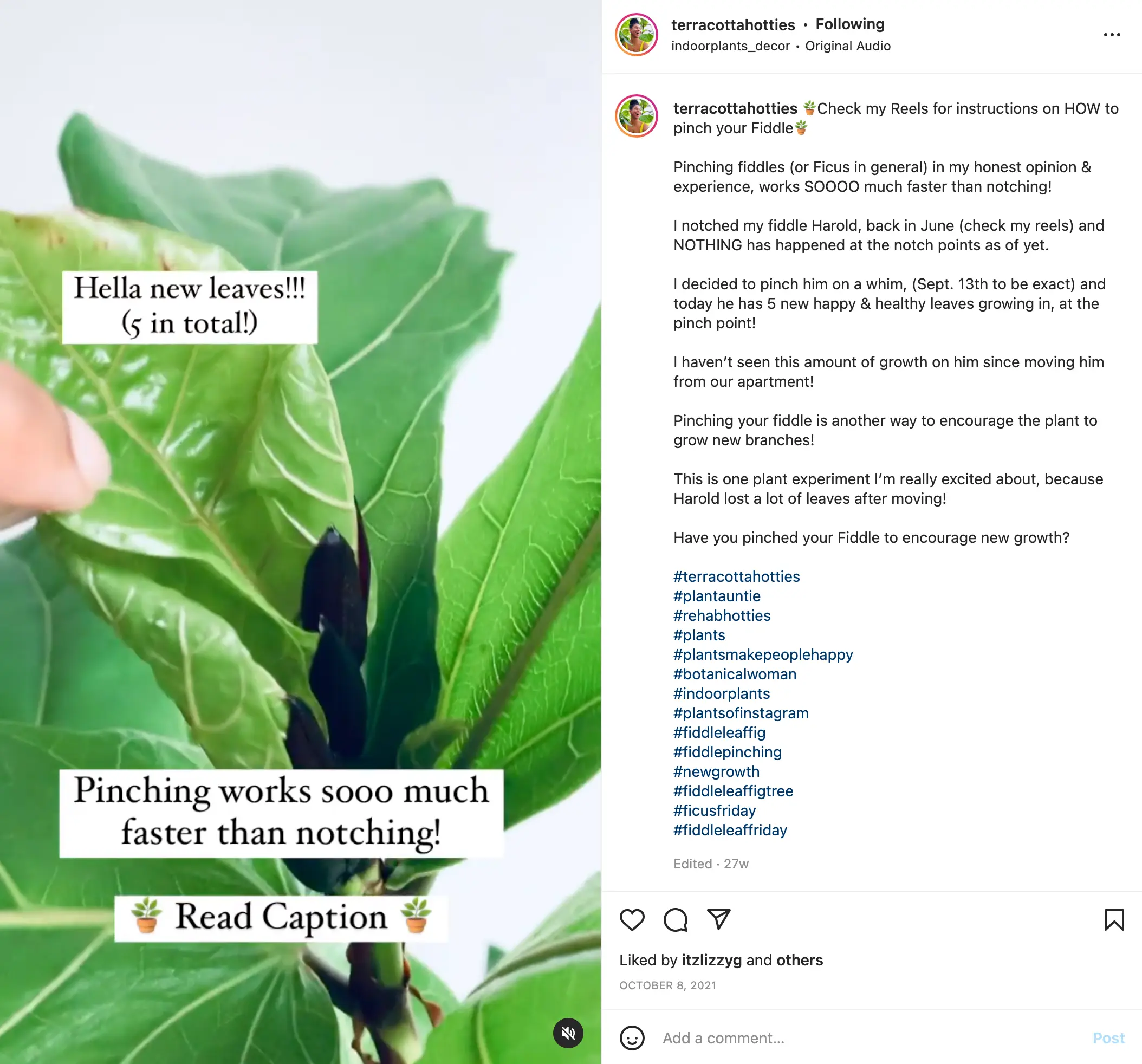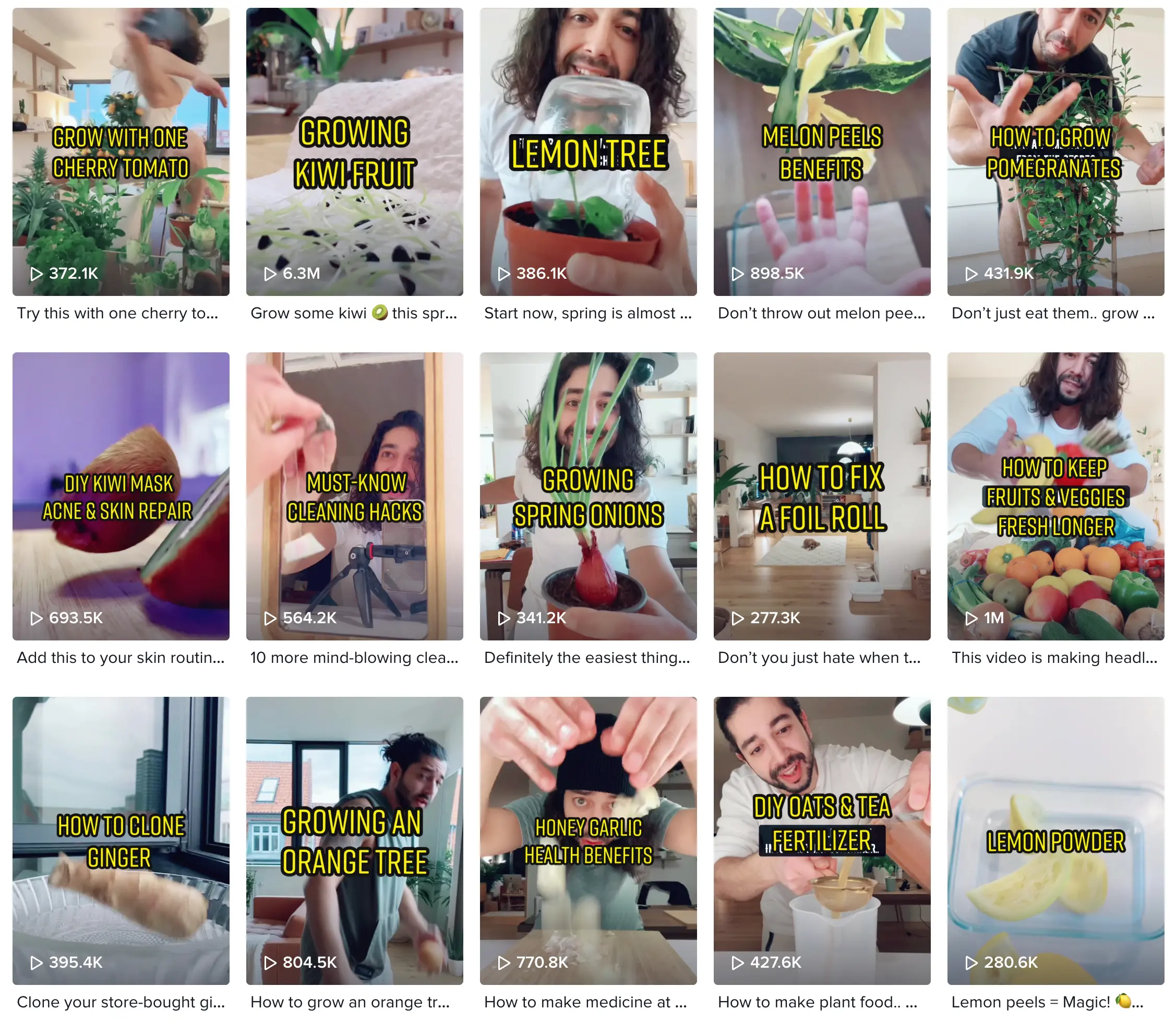
DIY houseplant pros on the art of creating how-to videos
Published on April 27, 2022
On a recent weekend, I approached my fiddle leaf fig plant with unusual trepidation. Watering? No big deal. Lighting? Plenty. Instead, I was about to do something I had never done before. I was, quite literally, about to nip my plant in the bud.
On Instagram, plant enthusiast Katura Barnes—AKA @TerracottaHotties—showed me how. She reached into the crown of her own fiddle leaf fig, where the leaves met the stem, grasping for the bud at the center. Given enough time, this bud would grow into a new leaf, too. But instead, she told me to pinch it right off with a a twist and a snap. Like a magic trick, two leaves would now grow where there would otherwise be one.
Among her followers, “fiddle leaf figs used to be the biggest problem child that no one could really figure out,” Barnes told me. “A lot of people were like, ‘Go to Katura. Go to Terracotta Hotties to figure it out.’” So she started a series of how-to videos on caring for fiddle leaf fig plants.
Barnes’ videos are simple and to the point. They’re usually set to catchy music, with quick, glamorous shots of her plants in varying states and stages—being watered, re-potted, trimmed, and coaxed into producing new growth. They’re easy to follow and strike the right narrative balance between show and tell.
It’s an impressive skill, and one that more and more people have had to pick up over the last two years. Remote work means we can’t always teach people the way we used to—hands on, over the shoulder, side by side, in real time. Now, we share our screens during Zoom calls or use new tools like Dropbox Capture to record short instructional videos for colleagues to watch and re-watch at their own pace.
But a good how-to video can be deceiving in its simplicity. What does your audience need to see—and how much, and for how long? Do you narrate the video, place text on-screen, or maybe both? What details are the most important, and how much is too much?
Whether you’re propagating a beloved plant or showing a teammate how to file an expense report, here’s how to keep your audience engaged, teach them something new, and get your points across effectively without losing them along way.
Start off strong
Armen Adamjan—AKA @CreativeExplained—is the TikTok king of kitchen hacks. In some of his most popular videos, he takes grocery store fruits and vegetables—pomegranates, lemons, tomatoes, avocados, cherries, mangoes, and lychees—plants their seeds, and watches them grow. In others, he propagates snake plant cuttings, regrows lettuce, and makes fertilizer from ingredients he already has at home.
But what sets Adamjan’s videos apart is how they crackle with a level of energy and enthusiasm uncommon to most how-tos, a flurry of motion from the very first frame. It’s a purposeful, savvy trick to stop viewers from scrolling onward through their feed.
“I started thinking, How do I capture people's attention?” recalls Adamjan, who now has more than 3.9 million followers on TikTok, and another 1.2 million on Instagram. “You have two seconds, maybe three sometimes.” It’s why his videos so often start with a leap, a jump, an excited Adamjan sliding into frame, bursting with excitement over a skill he can’t wait to teach.
'I realized nobody's going to sit through a 30-minute video of me talking about this plant,' says Barnes
Early on, Adamjan would also start his videos with longer preambles—describing the outcome first before walking viewers through each step. “In the beginning I said, ‘What's up guys. Awesome garden trick. Check this out,'” Adamjan says. But he found the number of people watching, sharing, and engaging with his videos went up the sooner he got to the point. Now, Adamjan says, “I'll say ‘Did you know if you grab a lettuce…’ or ‘You won't believe what you can do with a lettuce…’ so it makes them stay.”
Short and simple
When Barnes realized just how much she had to say about her beloved fiddle leaf fig plant, she decided to turn it into a series, rather than one long video. “I realized nobody's going to sit through a 30-minute video of me talking about this plant,” says Barnes. “So I was like, let's break it up.”
Barnes has found shorter videos are especially helpful for new gardeners, who are usually looking for answers and not lectures. “I try to make sure that you get the point, but I don't have to spend too much time on that particular part of the point,” says Barnes. “I'll show you, like, ‘Okay, I fill the pot halfway and then I put some soil on top.’ I'm not gonna bore you to death with putting dirt all the way around and packing it in.”
When it comes to engaging viewers—and keeping them from leaving—there’s a delicate balance between including too much information and not enough.
“In the beginning, I just did quick sentences […] and no real explanations or descriptive words,” says Adamjan. “People in the comments would say ‘Can somebody confirm this?’ or ‘Is this true? This is vague.’” Now, he won’t just tell you to put an apple seed in the fridge, but will actually explain the concept of stratification along the way.
'Every shot matters. Every take matters,' says Adamjan. 'I can say the same, like, one line eight, nine or 13 times'
But Adamjan has also learned that he can’t be too detailed, either. “There's a lot of information that's coming at people when I do my videos, and I have to squeeze it into one minute,” says Adamjan, who essentially edits each shot in his head as he goes, counting up the seconds it takes to shoot every scene and say every line. "It all depends on how much time I have left in my head.”
Practice makes perfect
While Adamjan may now be known among his followers for his enthusiasm, his videos didn’t always sound this way. In fact, the first garden trick video Adamjan uploaded to TikTok in 2020 was matter-of-fact, unedited, and shot in a single take. “It started off with a quiet, kind of mellow mood,” he said. “It was just like, ‘Hey guys. When you're done cutting the ends off green onions, don't throw them out. Do what I do.'” In time, he realized that audiences were more likely to get excited about what he had to share if he looked and sounded excited, too.
The more videos Adamjan creates, the more his approach to teaching and presentation has improved. He’ll often re-make his older videos to try and find different or more effective ways of conveying a tip or technique. Or he might cut the video differently, add or remove the narration, or present the info in an entirely new way. “I'm a perfectionist,” says Adamjan, who also has prior filmmaking experience. “Every shot matters. Every take matters. I can say the same, like, one line eight, nine or 13 times.”
'I want to be myself in every one of my videos,' Adamjan says
Adamjan remembers one video about cloning ginger didn’t perform very well at first. But when he re-recorded it with better lighting, people loved it. The lesson? “Natural light will change your videos,” Adamjan says. “I didn't really care about lighting that much. But when I started doing that it changed everything.”
Good visuals are hugely important for Barnes, too, who has also worked as a photographer; she loves a good background, a bright room, and great color, and will spend the time to get it all right. “I get frustrated really easily if it's not what I want it to be,” says Barnes, laughing. “Especially if I get all my shots, and then I work on it at night, and now it's dark and I’ve potted the plant and I can't go back and redo it.”
But don’t overthink it
Though the level of polish in their videos might suggest otherwise, Barnes and Adamjan say they don’t actually plan or script out their videos ahead of time, which is part of what makes their how-tos feel so natural, spontaneous, and authentic. “I'm always in the middle of doing it,” says Barnes—be it trimming, watering, or repotting—“and then it's like, ‘I should record this.’” Her videos literally capture what’s happening in the moment, like a friend teaching you a new trick or technique they just learned. “I'm learning,” she says. “I'm finding it out in real time, too.”
That authenticity is a big part of the draw. Adamjan may change up the narration, or re-shoot something anew, but what never changes is how he presents himself—ever enthusiastic and eager to share. “I want to be myself in every one of my videos,” Adamjan says.
Behind the scenes, both Adamjan and Barnes have used Dropbox to share video files, and have also found creative ways to monetize their work. Sales of Adamjan’s two books—which are full of tips and tricks for indoor and outdoor gardeners—have enabled him to work on Creative Explained full-time. Barnes runs Terracotta Hotties in her spare time and offers indoor plant consultations to her followers—like those struggling with their own troublesome fiddle leaf figs.
In fact, it was while watching Barnes work with her own fiddle leaf fig plant that I realized something else: a good how-to is as much about what you’re taught as what you take away. What Barnes gave me—what she gives all her followers—wasn’t just a set of steps, but the confidence to try something new.
“My ultimate goal is to kick that fear out of becoming a plant parent,” Barnes says. “I just want people to know that owning plants doesn't have to be intimidating and everybody has a green thumb.”







